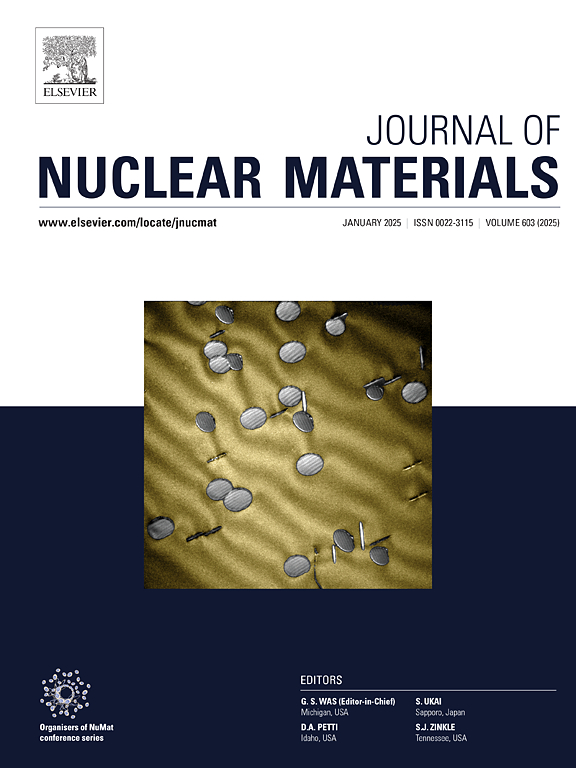Exploring the kinetic mechanism of dehydrogenation based on yttrium hydride surfaces: First principles calculations
IF 2.8
2区 工程技术
Q3 MATERIALS SCIENCE, MULTIDISCIPLINARY
引用次数: 0
Abstract
A fundamental understanding of the dehydrogenation mechanisms of yttrium hydride (YH2) is of great importance for its applications in neutron moderator. In this study, we have employed density-functional theory (DFT) to systematically investigate the surface structures and the relative stabilities of low Miller-index YH2 facets, with particular emphasis on their dependence on environmental parameters (hydrogen partial pressure and temperature T). Based on the computational results, a surface phase diagram of YH2 was obtained for a wide range (300 -1100 K). The YH2 surfaces tend to be dominated by the stoichiometric (111) facet with the 111-stoi-4H termination and the surface energy of 0.78 J/m2. Two additional surfaces, 100-non-2Y and 110-non-2Y1H, will be exposed at the extremely low H partial pressure condition. Then, several possible dehydrogenation pathways were explored to elucidate the dehydrogenation mechanism based on these three surfaces. The results show that the dehydrogenation process in YH2 primarily involves the formation of interstitial hydrogen atoms within the bulk, followed by the migration of these interstitial atoms from the bulk to the surface, ultimately leading to the release of hydrogen atoms into the surrounding environment.
探索基于氢化钇表面的脱氢动力学机制:第一性原理计算
对氢化钇(YH2)脱氢机理的基本认识对其在中子慢化剂中的应用具有重要意义。在这项研究中,我们采用密度泛函理论(DFT)系统地研究了低米勒指数YH2面的表面结构和相对稳定性,特别强调了它们对环境参数(氢分压ph2和温度T)的依赖。在较宽PH2范围内(300 ~ 1100 K),得到了YH2的表面相图。YH2表面以化学计量面(111)为主,端部为111-stoi- 4h,表面能为0.78 J/m2。另外两个表面,100-non-2Y和110-non-2Y1H,将在极低H分压条件下暴露。然后,探索了几种可能的脱氢途径,阐明了基于这三个表面的脱氢机理。结果表明,YH2中的脱氢过程主要是在体内形成间隙氢原子,然后这些间隙原子从体向表面迁移,最终导致氢原子释放到周围环境中。
本文章由计算机程序翻译,如有差异,请以英文原文为准。
求助全文
约1分钟内获得全文
求助全文
来源期刊

Journal of Nuclear Materials
工程技术-材料科学:综合
CiteScore
5.70
自引率
25.80%
发文量
601
审稿时长
63 days
期刊介绍:
The Journal of Nuclear Materials publishes high quality papers in materials research for nuclear applications, primarily fission reactors, fusion reactors, and similar environments including radiation areas of charged particle accelerators. Both original research and critical review papers covering experimental, theoretical, and computational aspects of either fundamental or applied nature are welcome.
The breadth of the field is such that a wide range of processes and properties in the field of materials science and engineering is of interest to the readership, spanning atom-scale processes, microstructures, thermodynamics, mechanical properties, physical properties, and corrosion, for example.
Topics covered by JNM
Fission reactor materials, including fuels, cladding, core structures, pressure vessels, coolant interactions with materials, moderator and control components, fission product behavior.
Materials aspects of the entire fuel cycle.
Materials aspects of the actinides and their compounds.
Performance of nuclear waste materials; materials aspects of the immobilization of wastes.
Fusion reactor materials, including first walls, blankets, insulators and magnets.
Neutron and charged particle radiation effects in materials, including defects, transmutations, microstructures, phase changes and macroscopic properties.
Interaction of plasmas, ion beams, electron beams and electromagnetic radiation with materials relevant to nuclear systems.
 求助内容:
求助内容: 应助结果提醒方式:
应助结果提醒方式:


